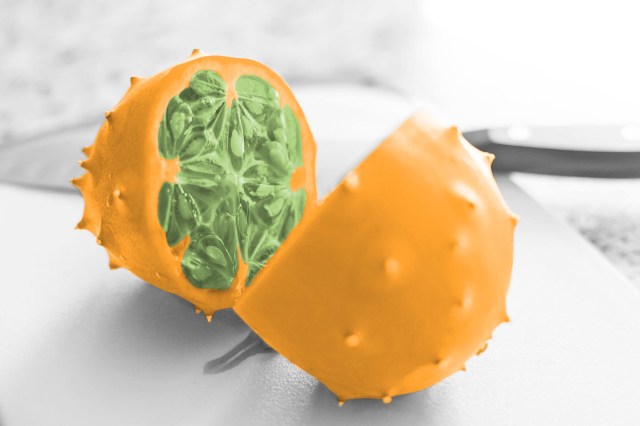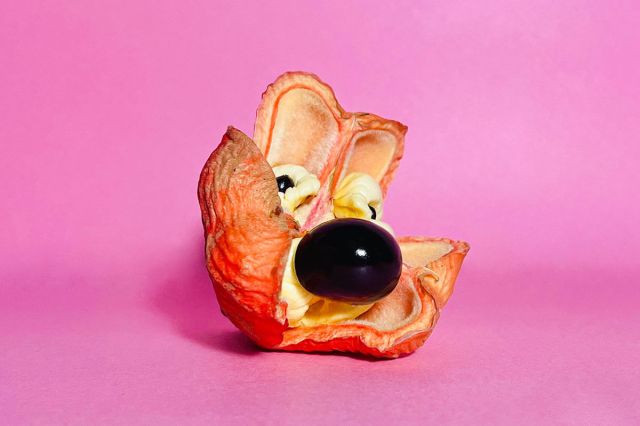
Ackee
The ackee tree is native to West Africa, and it produces one of the tastiest yet potentially dangerous fruits grown around the world. The fruit itself is visually comparable to a peach on the outside, but on the inside, it contains three fleshy white arils, each with a large black seed. Eating ackee before it’s ripe can induce poisoning, so you need to be careful before consuming it. But a well-ripened ackee fruit is known for having a creamy texture and a mild, nutty flavor, making it an absolute delight.
While the ackee originated in West Africa, it’s now particularly popular in Jamaica. Back in the 1700s, the ackee was brought to the Caribbean aboard ships carrying enslaved people. In the years that followed, the plant thrived in the island’s tropical climate. Ackee is so beloved in Jamaica that it’s a key ingredient in the country’s national dish: ackee and saltfish. In this recipe, ackee is boiled until it looks like scrambled eggs and is then served alongside fried saltfish such as cod or mackerel. The completed dish is garnished with bacon, tomatoes, chiles, or whatever else the eater desires.
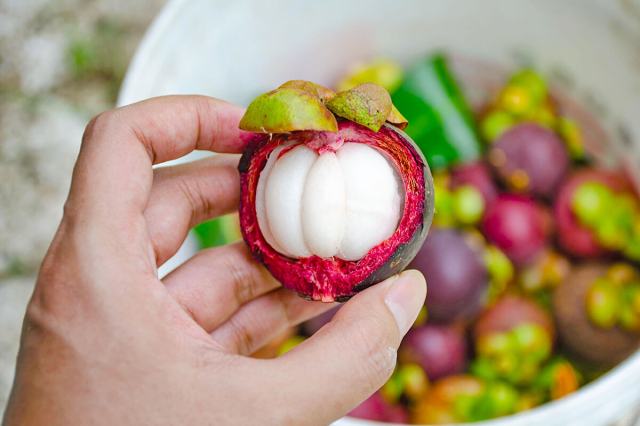
Mangosteen
Mangosteen is a sweet, juicy fruit that’s believed to have originated on the Sunda Islands of the Malay Archipelago. Today, the fruit is eaten throughout all of Southeast Asia and is particularly popular in Vietnam. Each mangosteen is roughly the size of a small orange, and features a hard purple shell on the outside with white fleshy fruit on the inside. It can be eaten fresh, dried, or canned and is often served in fruit salads, as a sorbet, or turned into a syrup or smoothie.
Mangosteen wasn’t introduced to the Western Hemisphere until the mid-19th century. It began to be grown in English greenhouses in 1855 and eventually made its way to the Americas. The fruit became particularly popular throughout Central America and the Caribbean, though it was actually banned in the United States until 2007 due to fears of importing fruit flies. Mangosteen must now be exposed to radiation to sterilize potential pests before it’s brought into the U.S.

Sapodilla
Cultivated throughout Mexico and Central America, sapodilla is a tan-colored fruit with a roughly textured coating. In much the same way you might determine an avocado’s ripeness, you should make sure a sapodilla feels hard to the touch before eating. In fact, if you eat an unripe sapodilla, the flesh will induce an unpleasant sensation akin to cotton mouth. Once the rind begins to soften, the sapodilla is ready to consume, and it should have a musky and malty flavor similar to molasses.
Sapodillas are often blended into smoothies, served alongside ice cream, or mixed with other fruits to create jams and jellies. Historically, chicle — milky sap from the sapodilla tree — was actually used as chewing gum by the ancient Aztecs. The tree was also cultivated by the Maya, who used its wood for carving; these 1,000-year-old carvings can still be found throughout Maya ruins in the region.
More Interesting Reads
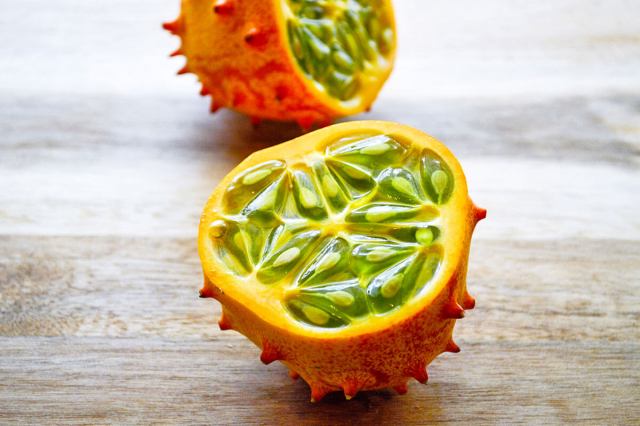
Kiwano
The kiwano melon is a fruit native to Kenya, Malawi, Sierra Leone, and other parts of Africa that’s known for its striking appearance. On the outside, the fruit has a spiky yellow shell, which explains why it’s been given the moniker “African horned cucumber” in the U.S. On the inside, however, the fruit is full of gooey green flesh and seeds. If eaten when still immature, the flesh of the kiwano is said to taste like a cucumber. But once it’s ripe, the fruit develops flavors reminiscent of melon and kiwi.
The otherworldly appearance of the kiwano melon has also earned it a unique place in American pop culture. The fruit was used as a prop in an episode of Star Trek: Deep Space Nine titled “Time’s Orphan.” In the episode, the kiwano was referred to as a “Golana melon” and is said to be cultivated on the alien planet of Golana.
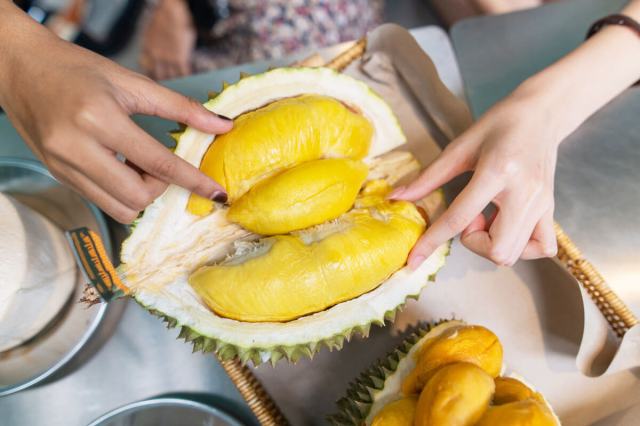
Durian
The durian is one of the most notorious fruits in Southeast Asia, as it’s both beloved for its flavor and reviled for its odor. Each durian has a large spiky shell that protects the creamy and almost custard-like flesh inside. This soft interior is said to taste like a mix of caramel, vanilla, almonds, and even cheese. Durian fans adore the complex flavor profile and will eat it on its own, bake it into cakes and pastries, or serve it up in a smoothie. Some even say durian is best enjoyed when it’s overly ripe, as it develops a texture akin to sour cream.
But when you crack open a durian, you’re also overcome by a pungent aroma that’s been compared to rank garbage or rotten eggs. Because of its powerful and off-putting smell, durian has been banned in many Southeast Asian countries on public transport and in other communal gathering places such as hotels.
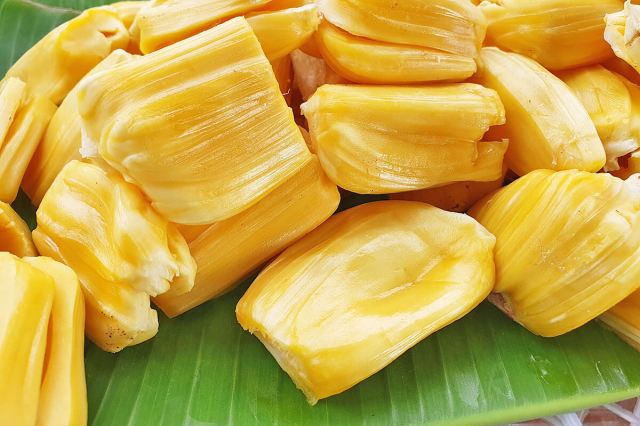
Jackfruit
Jackfruit is the largest tree-borne fruit in the world, weighing anywhere from 10 pounds to a whopping 80 pounds. The fruit is particularly popular in Bangladesh, where it’s considered a staple crop, though it’s also widely popular throughout the rest of Southeast Asia. It takes five to seven years for a jackfruit tree to begin producing fruit, but once it does, it’s likely to produce between 150 and 200 fruits annually. The jackfruit has a spiky rind with a yellowish-green color, and the creamy flesh inside is said to bear a similar texture to an overripe banana.
While jackfruit has been cultivated for thousands of years, it’s become particularly popular in recent years among vegetarians and vegans. When it’s cooked and shredded, jackfruit develops a texture akin to pulled pork, and it’s great at absorbing the flavors of the other foods it’s cooked with, making it a fantastic alternative to meat.
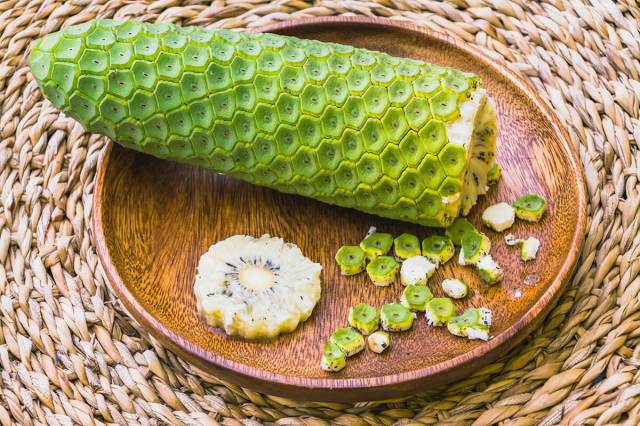
Monstera Deliciosa
The name monstera deliciosa means exactly what it sounds like — “delicious monster.” The fruit comes from a plant native to Central America that’s also known as the “swiss cheese plant,” as its leaves are riddled with natural holes, resembling swiss cheese. The shell of the fruit looks like an ear of corn, only harder and greener. The fruit inside even resembles the kernels of a corncob — but the flavor isn’t corn-like at all.
If you eat monstera deliciosa too soon before it ripens, you’re bound to have a deeply unpleasant experience. The sour, bitter taste is no friend to your tastebuds, and the oxalic acid can irritate your throat. But that acid dissipates as the fruit ripens, and the flavor becomes more akin to a blend of pineapple and banana. You can tell the fruit is ripe once its outer scales begin to naturally peel. When that happens, throw it in a fruit salad or just eat it on its own for a wonderfully sweet treat.

